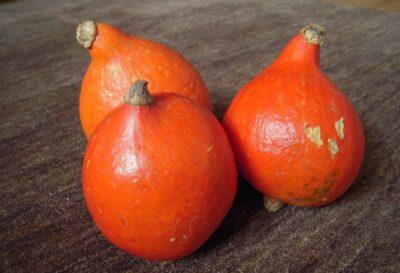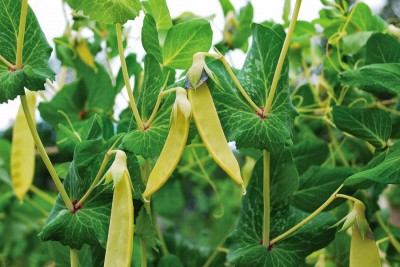
Hokkaido Pumpkin/Squash Image source: sweetartichoke.com
In gardening as in life, it can be easy to fall into the same familiar patterns. Year after year, there are certain vegetables that we just always seem to plant. And it’s only natural that we should develop favorites that we love to grow and enjoy every season. But if we only plant the familiar, we are missing out on the opportunity to enjoy new visual sensations in our gardens and new taste sensations in our meals.
By planting a few uncommon, unusual or heritage vegetables, you will be able to embark on a new gardening adventure. Make sure you look at the seed packages to get the planting correct. Some of these special plants have specific instructions and preferences and you want to make sure they will grow in your area.
Here are a few favorites for you to consider.
1. Hakkaido Pumpkin
This vibrant orange pumpkin originally came from the Far East. It spread to America and took root in New England. The Hakkaido pumpkin (also called squash) continues to gain popularity, especially today as it has been proven beneficial to a healthy lifestyle.
It can be used for jams, side dishes, soups or sauces. It is rich in vitamins and minerals including A, B and C, as well as phosphorus, potassium, calcium and magnesium. The pumpkin is beneficial and suitable for diabetics. Some people even use it for its detoxifying abilities.
Order your 2015 Heirloom Solutions seed catalog and get $20 in your account!
You can start this plant indoors. Soak the seeds overnight and then plant them about an inch apart in good soil. This plant needs regular weeding and adequate moisture. It is usually harvested in the autumn. A bonus to growing this pumpkin is it can be stored in a dry basement for up to six months.
2. Fleener Topset Onion
This onion also goes by the names Egyptian onion or winter onion. It is unique as its bulbs are three times larger than regular onions. To describe the appearance, Fleener Topset onions are like a mix between scallions and regular onions. On the top of each stalk there are what is called bulbils (bulblets).
Fleeners are hardy, mild tasting and can be grown almost year round. This onion can grow to three inches in diameter. It seems to do well in any garden, and can even survive in a fairly dry garden.
Plant Fleener onions in the summer or autumn. They do well in a sunny spot. Seeds should be placed about one to two inches down and about 10 inches apart. Buying bulbs will save you time.
3. Golden Sweet Pea

Golden Sweet Pea. Image source: susansinthegarden.blogspot.com
Known to be a bit sweeter than the regular green peas, golden sweet peas have a lovely rich yellow color. They begin with vibrant purple flowers, followed by pods. The pods are yellow and grow to be about three inches long.
Whether you plant seeds or seedlings, install a support or trellis at the same time. Plant in the early spring, in good soil. Place the seeds one-and-a-half inches deep. The soil needs to be well-drained.
When the pods get to be three to three-and-a-half inches big, it is time to pick them. If they get too big they can be bitter.
4. Yellow Cheese Pepper
This pepper is fun, and interesting to look at. The pepper is yellow and squash shaped, but pepper sized. It takes 73 days to mature.
The flavor mixes well with salads and with other green and red peppers.
New Natural Fertilizer Doubles Garden Production!
You can sow the pepper seeds in a garden or in a greenhouse. Seeds need to be planted one-fourth of an inch deep, covered lightly, and kept in a well-ventilated area. If grown in a greenhouse, sow in February or March. Check your plants often. Aphids tend to like this plant. Transplant the seedlings in June when there is no chance of frost and the plants are around 12 to 18 inches tall. Soil should be warm and sandy.
5. Finocchio
Finocchio is sometimes called Florence Fennel. It is a cool season crop with a mild licorice or anise-type flavor. It has a bulb-type bottom and multiple leafy stalks.
It is often used in salads, as a supporting vegetable, or even cooked on its own. Always wash it well, as dirt usually gets in between the layers and stalks.
It can be planted in early spring or summer. This plant does need its own area, with at least 12 inches between plants. Finocchio also needs soil that can hold moisture and is rich. If using seeds, plant around July 1. Once the plants grow leaves, water regularly, but don’t over water. Harvest Finocchio bulbs when they are three inches across.
6. Violet Queen Purple Cauliflower
The purple color of this vegetable catches the eye immediately. Its taste is between broccoli and cabbage. It is a compact and quick growing plant, easy to grow, and is mostly pest and disease resistant.
Violet Queens turn green when cooked.
Sixty-five days are required to fully grow this vegetable. You can start the plants indoors and transplant when there are leaves. The cauliflower needs moist, rich soil. Place the seeds about one-fourth of an inch deep in warm soil.
7. Dinosaur Gourd
Finally, you might have fun growing a non-edible plant for decorations.
Dinosaur gourd is a slim-necked, round-bodied gourd with a textured exterior that looks like some sort of Brontosaurus. Although you can’t eat it, it is very popular in fall centrepieces. In the past, it has been used for utensils and storage containers.
It is actually from the family of cucumbers, pumpkins and squash. The dinosaur gourd is a vine plant, so it grows best on a trellis or supporting structure.
Sow seeds one inch deep in good soil when there is no chance of frost. It is a good idea to space the plants about six feet apart for growing room. This plant also can be started from seeds indoors and replanted outside when frost is gone. They like full sun.
So brighten up your garden this season with unusual vegetables. You will have new conversation starters and create some new dishes with your exciting bounty. Let your adventure begin.
What vegetables would you add to this list? Share your thoughts in the section below:
Do You Know The Biggest Mistakes Gardeners Make? Read More Here.
 Off The Grid News Better Ideas For Off The Grid Living
Off The Grid News Better Ideas For Off The Grid Living



